“I wonder we ain’t all drownded” a Forester said to me on a December morning, while walking his dog round the lake. I was fishing for rainbows in the mud-stained water, there being no obvious opportunity to fish the flooded rivers anywhere. As usual, it was pouring with rain and had been since dawn. I was using an intermediate line, a black lure to show a good profile through the murk and a very slow retrieve. This certainly works, but under these circumstances it is about the only method which works with any consistency. After a few days it can get quite dull. I must say this autumn has been very frustrating, with constant flooding since the end of September. I feel embarrassed by my earlier optimism, having promised everybody at the beginning of the season (including members of the Grayling Society) some gorgeous autumn fishing as the leaves changed colour. This year, it was not to be. I did do quite a lot of clay pigeon shooting, which is a new thing for me. On reflection, I will rephrase that. I did a fair bit of shooting at clay pigeons. More of that on another occasion.
 Forest pool on Christmas morning
Forest pool on Christmas morning  Forest pool rainbow
Forest pool rainbow Many other anglers were frustrated by the conditions, but there was some relative success here and there. On the last day of November, KD of Swansea had a bag of 15 grayling from the Irfon at Llanfechan. AG from Cadiff, fishing the same day at Cefnllysgwynne on the opposite bank, recorded 11 grayling. One of these fish he identified as having been caught by him no less than four times this year! That is certainly interesting. I don’t believe that grayling are exactly stupid – they can be remarkably cute – but let us say they can also be quite obliging at times! I also recall a particular Monnow trout which I caught three times over a few weeks. Certain fish are recognisable due to scars and other distinguishing marks, but in other cases I dare say we don’t recognise old friends and in fact the same fish are being caught more often than we realise. Specimen hunters in the coarse fishing world are well aware of individual fish and these sometimes achieve the distinction of their own names. I once caught a leather carp known as Gertie (Gertie-Thirty because she was always around 30 pounds). There was that large barbel, the Traveller, which was so christened because it moved such distances up and down stream, although personally I prefer to imagine it was named after Confederate General Robert E Lee’s famous grey horse.
My thoughts are wandering so back to our rivers in December: MH from Llandrindod Wells had another good day trotting with maggots on the GPAIAC water at Builth Wells and accounted for 23 grayling to 2.2 pounds. On the 5th AG from Harleston in Norfolk was in our area again and fished at Doldowlod. He described the water as “low,” which I find surprising although there was a brief respite in the rainfall about then. He did succeed in catching 5 grayling to a creditable 17 inches, although on the following day he was unable to fish at Cildu at the top of the Irfon due to renewed flooding. On the 7th JH from Epsom with a friend trotted in high water at Cefnllysgwyne and between them managed 5 grayling from 10-16 inches. There followed a huge gap when really nothing much could be done, so high were rivers everywhere. On the 27th LT from Ynys Mon had 4 grayling from the Dee at Llangollen Maelor. I went trotting a couple of times and distinguished myself by breaking the top joint of the 14 foot float fishing rod I use for the Wye. This was an act of sheer carelessness – I was in a hurry to get home and drove off with the joint still on the bonnet of the car. And I hate careless treatment of rods when I see it inflicted by others! Only by New Year’s Eve, the time of writing, did we have established a period of more normal weather with the water levels falling steadily. Looking on the bright side, there doesn’t seem too much rain predicted for early January, so we should get some fishing opportunities now.
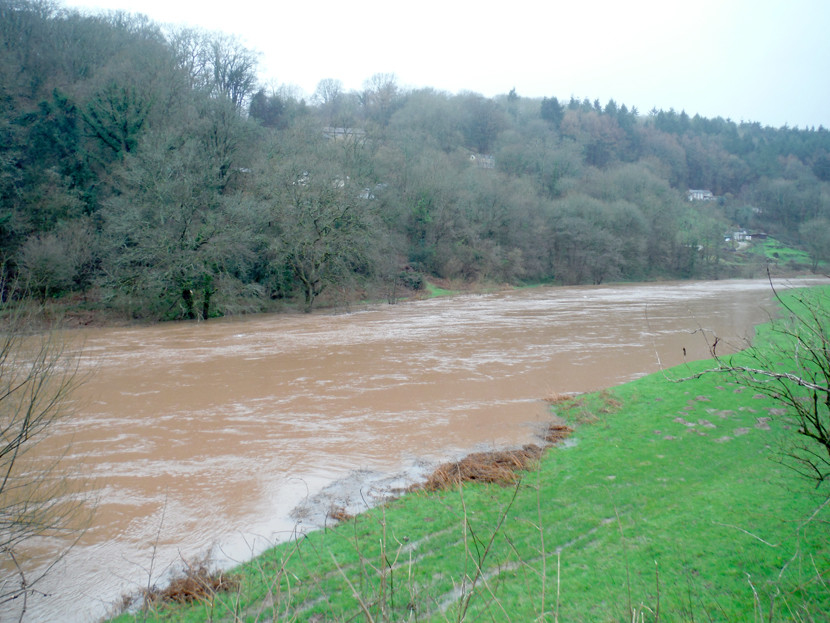 Cadora flood
Cadora flood 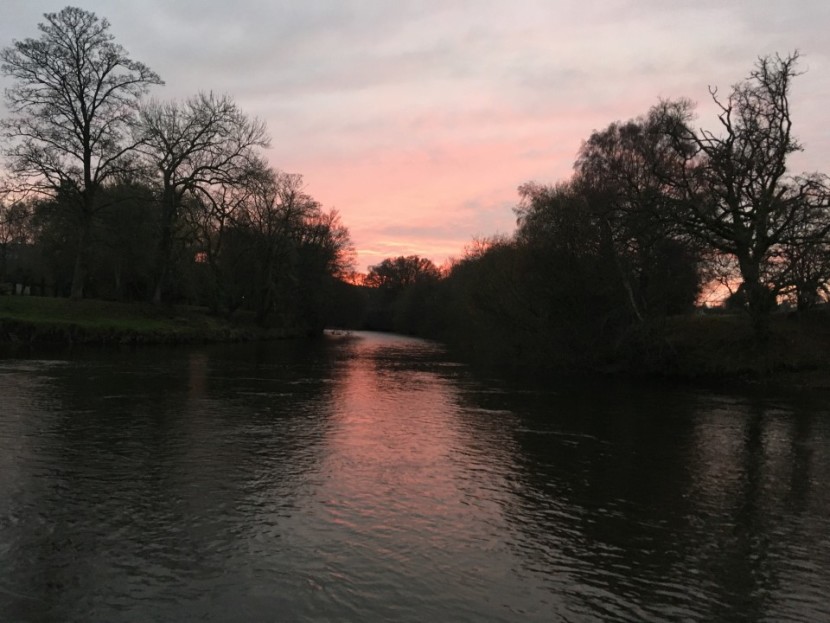 Mouth of the Irfon - MH from Llandrindod Wells
Mouth of the Irfon - MH from Llandrindod Wells 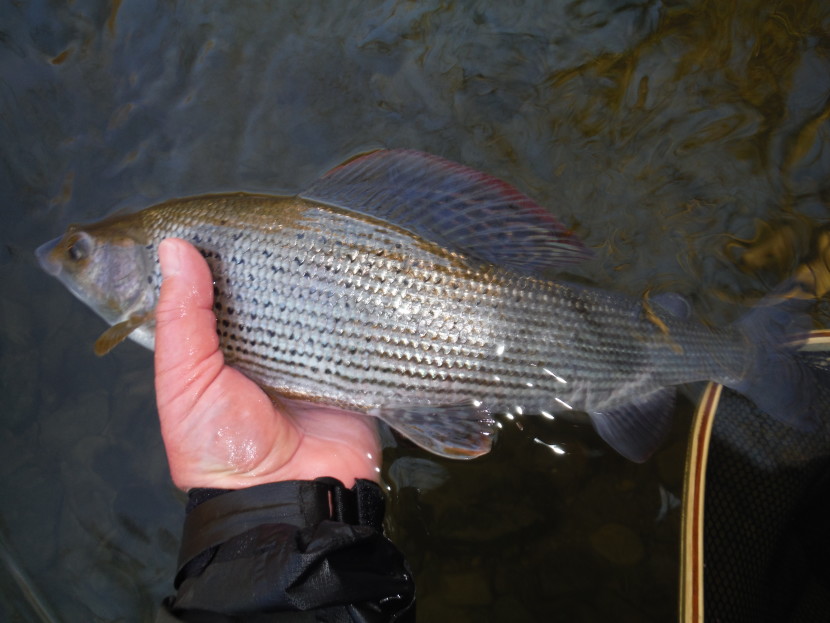 Cefnllysgwynne grayling
Cefnllysgwynne grayling Sadly, we seem to be reading a lot of obituaries in the magazines lately. The most recent collection is for the Cumbrian-based angler and writer, Malcolm Greenhalgh, who died last month. I can’t add much to the remarks of those who knew him well, but a brief conversation at a game fair impressed me with his wit and charm. On that occasion he was talking about North Country-style spider fishing, an enthusiasm which I shared.
More than 30 years ago, Dr Greenhalgh cut short a career as a college lecturer in biology to fish and write about it full-time. This was quite a brave decision to take at 40 years old – not a path likely to lead to monetary riches as I can attest – but his readers will be thankful that he did. He became widely known in the angling world and his various and numerous books are listed in the magazine obituaries. I suggest his legacy is one of an all-round game angler, a character slightly less common today, in that he pursued with equal enthusiasm brown trout, grayling, sea trout and salmon.
Early in his career he was a friend and protégé of Hugh Falkus, but not so over-awed by his reputation that he wasn’t prepared to query some of the great man’s dictums about sea trout fishing. I particularly remember him writing letters to the press asking whether anglers on different rivers could tell him whether they really experienced the “first half, half time, second half, extra time” sea trout fishing periods into which Falkus divided his nights. (It seemed to me at the time that the Towy wasn’t at all like that). He was a great salmon angler, although sadly his deteriorating health prevented him from that branch of the sport in the final years. In his prime with family and friends he enjoyed cooking fish as well as game birds, feathers from which came in handy for the delicate spiders he liked to tie. I will remember him for the simple yet extremely useful little leaflet he wrote for Partridge Hooks about tying and fishing spider patterns.
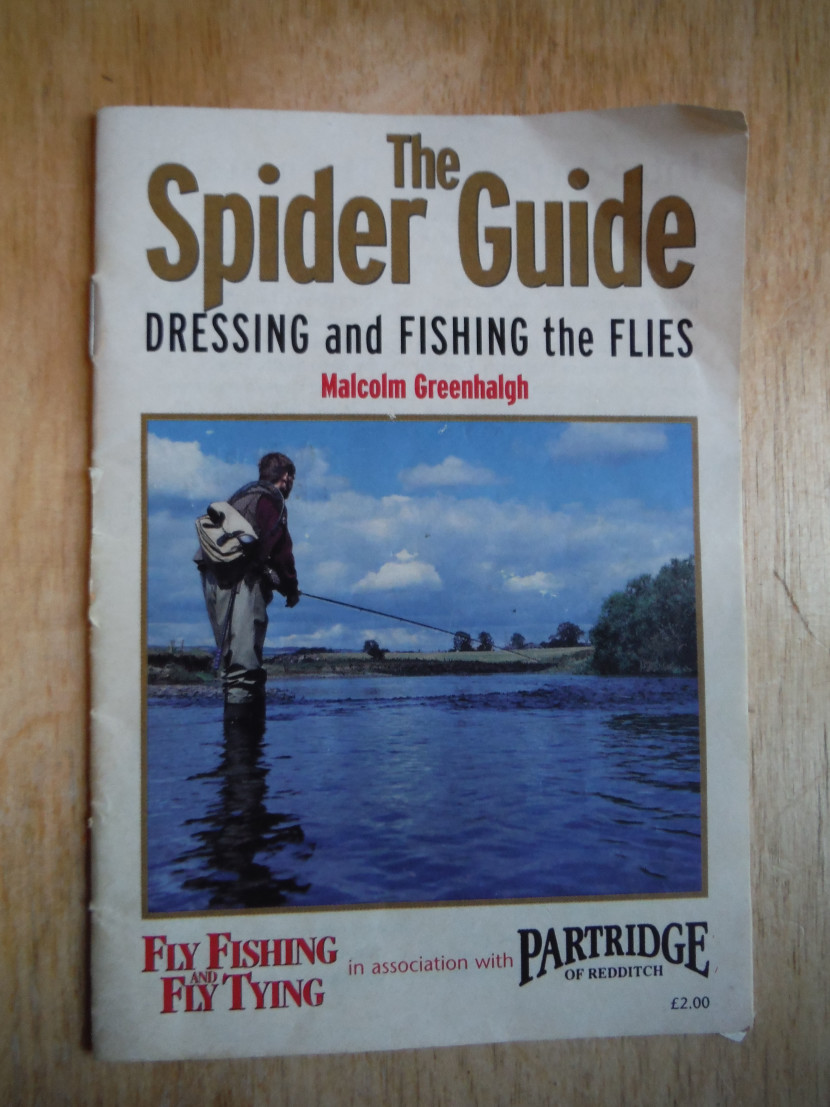 Malcolm Greenhalgh on spiders
Malcolm Greenhalgh on spiders Here is a subject which deserves more attention than it usually gets. Landing nets are rarely much discussed in fishing circles and when you start off in the sport the net is the final accessory which you buy in the shop, probably as an after-thought once the really interesting decisions about rod, reel and line have been made. However, when you think about it, having one which works well is quite important. You need a net which is big enough, easy to deploy, but not too heavy to carry. Otherwise, there isn’t so much to write about looking after your net, beyond hanging it up to dry when the day is finished and being careful to repair any damage or holes which occur in the mesh. It’s remarkable what a small hole even a good fish can find its way through.
If you only fish small streams, you might think you don’t need a net at all. Well, think again! Even a small stream can occasionally produce a trout or grayling which can really cause you trouble. The best trout I ever had from the Escley Brook was a superb 16 inch cock fish from a deep hole. As it happened, that was on a hot summer day when I had decided that surely it was not worth carrying a net for such a tiny shrunken stream. In the event I did manage to bring the fish safely to hand, but I was lucky.
Of course we all bring parr and small fish to hand and why not? Swing them in or play them in, hold them gently in a wet hand while unhooking and off they go with the minimum of harm. With experience you learn what size of fish can easily be brought to hand and unhooked while you are wading in the river; if in doubt, the ideal situation is to have the net waiting on your back for when you decide you need it. I suppose during a busy grayling session I might handle fish of up to 12 or 13 inches, but I will probably choose to use the net for 14 inches and larger. Here are the types of nets which I regularly use and which are currently hanging on my garage wall:
Net A: For many years this has been my standard wading net for wild trout and grayling fishing, whether on main rivers or smaller streams. It was chosen for the main reason which over-rides all other considerations – lightness. I have enough to tote around in my fishing vest without adding more weight to my poor old shoulders for no reason. Some may think it too small, but with a mouth of 16 inches length by 7 inches width, it’s surprising what you can get in there providing you get one with a reasonably deep bag. Long ago I decided that what is important about the mouth of a small net is length, rather than width. Imagine yourself crouching down in the last stages of the fight, carefully drawing a tired fish towards you on the surface with the rod tip moving behind your head. The fish will be on its side – if not you are asking for trouble – and its head will be pointed towards you.
You lift this long but narrow net from below and it engulfs the fish perfectly before it realises what has happened. It is most unlikely that in the final stages the fish will be lying across the net, so width is a quality not much in demand. The mesh is knotless and fine, so unlikely to damage scales or fins. The wooden frame floats, a quality useful in itself, and the handle is attached to the angler by a flexible extending cord (I favour the coiled kind like an old-fashioned telephone cable). The head of the net is attached to one side of a magnetic release mechanism, the other part of which is attached to a D-ring on the back of the waistcoat or rain jacket. Thus the net hangs head-up, handle down, on my back when not in use. I like it that way round because it keeps the mesh away from brambles and other entanglements when I am moving along the bank. When I want to use the net, I put my left hand behind my back to feel for it, then tweak the magnet apart. To replace the net, again it is a one-handed job to feel for the magnet and re-attach it.
 Net A
Net A Net A1: Just to prove the point, here is the same net with a surprise chub of a fair size in it. The big fish goes in there all right, as will any normal brown trout or grayling I am likely to meet. In fact, if push comes to shove, I have learned that you can get it to accommodate an accidental salmon grilse if you can get the head in and hang onto the tail before you wade to somewhere suitable for unhooking. If it’s a full-sized salmon, of course that’s another matter.
Net A2: A 20 inch trout, accommodated easily enough.
Net A3 But not this. There are limits!
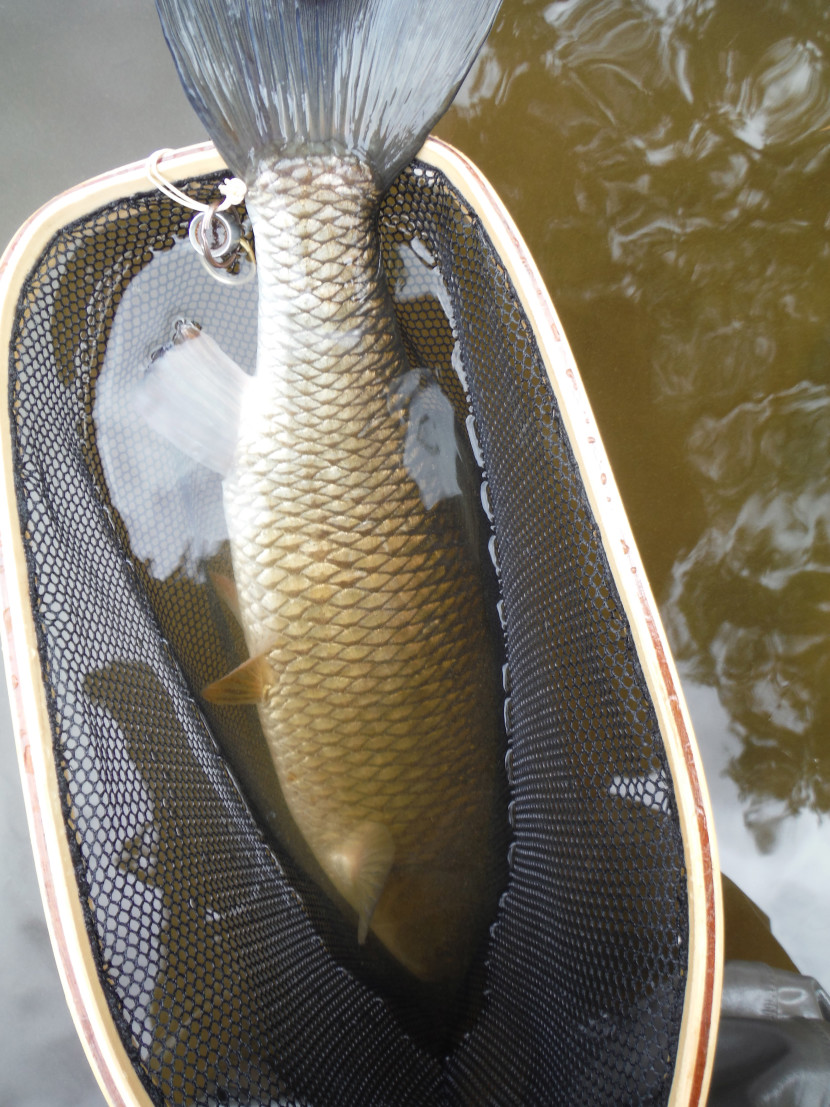 A1
A1 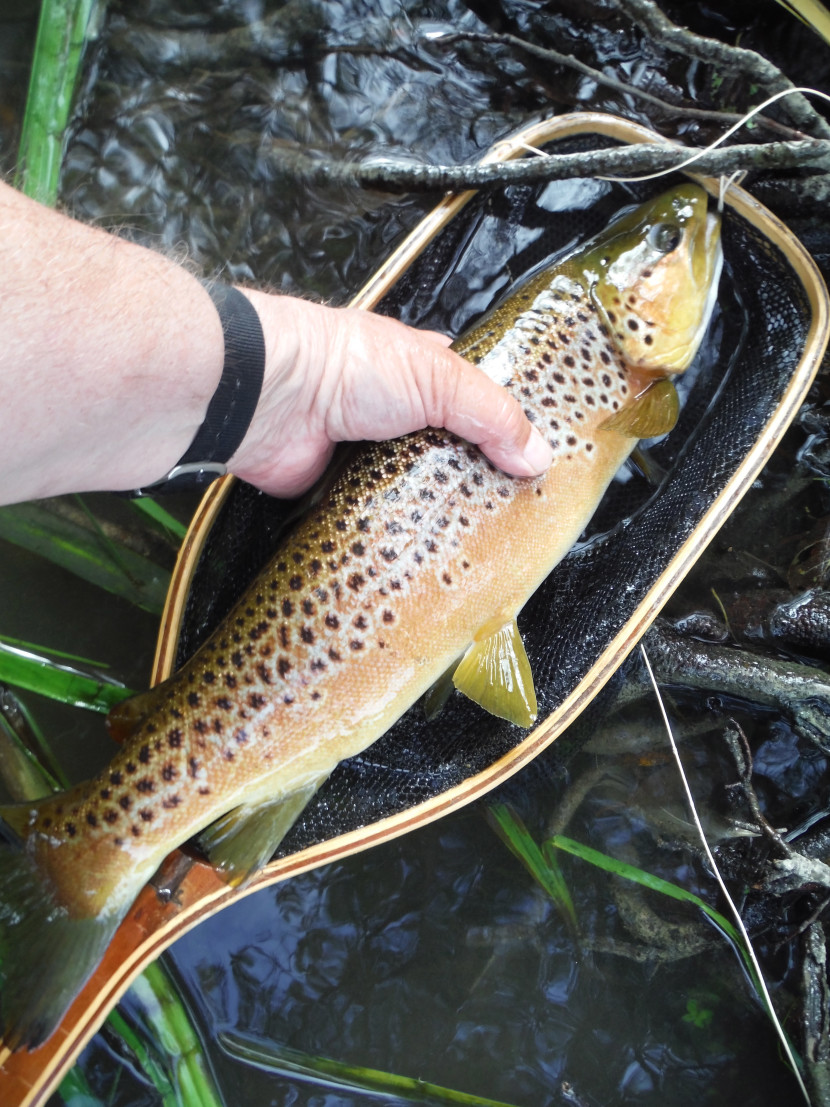 A2
A2 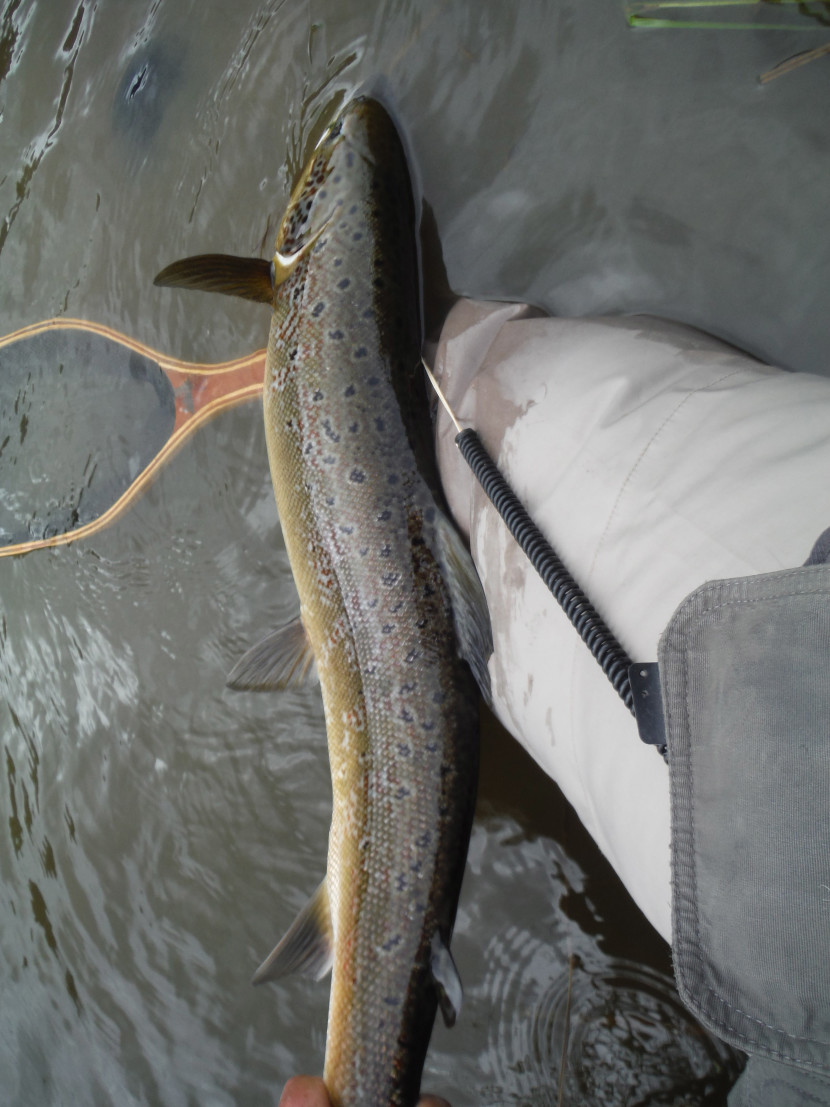 A3
A3 Net B: Another of the wooden wading nets, of the kind we used to call New Zealand-style. Incidentally you can pay an enormous amount of money for some of these designs, merely because of a highly polished wood inlay in the handle which adds nothing to the net’s performance. For some people it’s as attractive as highly polished Turkish walnut wood in a gun stock. Personally, I wouldn’t bother and a practical working model costs 25 or 30 pounds. This design is of the tear-drop shape more usually offered – 14 inches long by 11 inches wide. The problem for me with this particular one is that I have lost 2 useful inches of length in the aperture, the extra width is of no particular value when netting a fish, and it weighs more. I still like the long, narrow ones as in A, which you used to be able to get from Glasgow Angling.
Net C: An alternative cheap wading net for trout of a design which we see more and more these days. This one is 14 inches by 10 inches, so a bit small for my liking. The frame is an aluminium bow and actually lighter than many wooden nets, which is a definite advantage. It has a plastic mesh, which is useful in the sense that hooks don’t get stuck in it, but the bag is shallow making it difficult to deal with any but small fish. The net has a flexible loop of cord to go over the angler’s shoulder and when walking on the bank the net hangs rather awkwardly bag-down – a clumsy arrangement. I prefer the wooden wading nets.
Net D: Now we are getting to the serious stuff! This is a 27 inches by 20 inches gye net designed for sea trout, and large sea trout at that. It was made by Whitlock, although for reasons of comfort I replaced the original attachment cord with the harness shown. (Incidentally, can anybody tell me the origin of the word “gye” as used here? Wikipedia is of no help in this case.) The idea of the design is that the angler wades in the river with the net slung diagonally across his back. When into a fish and getting ready to net it, he releases the lower loop (Velcro fastening in this case) which holds the frame of the net to the top of the shaft near the handle, and the net slides under its own weight or the pull of the current down to end of the shaft and is thus extended ready for use, but still attached to the angler. Bearing in mind that all this must happen in the water and in the dark, so the net extending operation is not always quite as easy as it may sound. I try to keep the nylon sleeve connecting the frame with the shaft well-lubricated with WD 40, because if the shaft sticks in the sleeve it will be necessary to put one boot on the frame loop against the bed of the river while pulling the shaft out with the left hand – all this while playing an angry sea trout with the right hand. I could wish that this net was lighter, but when it comes to size I imagine it will deal with any large Welsh sewin I am likely to meet, as it certainly has done up to now. However, I had it with me one day when salmon fishing on the Wye and in a difficult pool (The Jackpot at Pwll y Faedda) I made three attempts to net a big salmon with it, failed in all of them and eventually lost the fish. Since then, I have always carried a proper full-sized salmon net when after the larger species.
Anglers carrying large nets on the bank quickly get into trouble with the mesh catching in vegetation, fence wires etc as they walk around. The usual solution for this is to catch the bag up and out of the way with a twisted rubber band. Now some go into the river with the rubber band fitted, although loosely, with the idea that when they net a decent fish, they only have to lift the handle, the weight will overcome the band and the fish will fall down into the bag safe and sound. In my experience, it doesn’t always work out that way! So I always take the band off ready for a fish when I go into the water, store it temporarily wrapped round the handle, and reattach it to the net when I get out to walk to another pool. Lyn Davies with other friends have a different solution to wandering around the countryside after dark with a sewin net. Lyn’s net frame is roughly D-shaped, about 22 inches across as best I remember, and rigidly attached to a shaft and handle of not much more than three feet long. One of those “bungee rubbers” from automotive shops with hooks at either end is knotted round the shaft where it attaches to the frame, and so he can wear the net round his neck and shoulder with the two hooks attached to each other. When he wants to net a fish, he detaches the hooks with his left hand, grabs the handle and he is ready. Now if you try this out with an ordinary short-handled net, you will find the net head will be the heaviest part and will hang down. However, Lyn has packed his handle with lead to balance that tendency and when he wears his net, the round frame is up at the top, behind his head and well clear of entanglements. Lyn’s net works well and he has used it to net a few for me. He got it from a car boot sale and unfortunately I haven’t managed to find another one quite like it.
 B
B  C
C  D
D Nets D1: Here they are at dusk, the three amigos, before they split up to different pools. Eifion, Gwynlais and Lyn, each ready for action with a weighted handle sewin fishing net of the type described.
Net E: This is a very nicely-made trout fishing net by Sharpes of Aberdeen, with a slightly tear drop-shaped frame measuring 21 inches by 19 inches. The handle is hinged to the frame and controlled by a spring-loaded locking sleeve for open or closed positions, and the handle itself is in two sliding parts, one inside the other. Fully unfolded and extended, the net has a reach of around 60 inches. You can carry it around folded at your left hip by a simple clip which slips onto on your belt. The net has quite a deep bag, although the large mesh implies a need for care to avoid splitting the fins of captured fish. I suppose that you could use this for sea trout fishing where the peal do not run too large and if you can manage the mechanism in the dark. Personally I find it just right for rainbow trout fishing in lakes when in practice I keep the net extended at all times next to me on the ground, picking it up when I want move to a new spot. Thus I only use the folding and sliding mechanism when putting it away in the car.
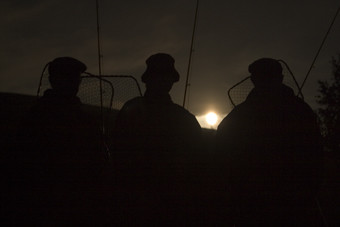 D1
D1 Net F: This similar design sold by Fishtec is also used by me for rainbow trout fishing on lakes. Unfortunately the spring on the locking sleeve has corroded and broken after much time and weather. Thus it has been clamped in the permanently opened position, which as far as my own use is concerned presents no problem at all. The vaguely triangular shaped head is 20 inches by 19 inches and perfectly adequate for rainbows of all normal sizes (it has accommodated double figure fish). The mesh of the net is fine and fish-friendly and, while capacious, it has a pan-shaped bag which makes access to unhook fish relatively easy.
Net G: Understandably salmon anglers of the past, casting a big rod and maybe encumbered with a wading stick, were not always keen to weigh themselves down with a net also. Hopefully the gillie would be carrying that! Lighter alternatives, if they had to be carried, might be a gaff or a tailer, both illegal to use now for obvious reasons as fish are to be returned. Not so many of us have a gillie on the spot to help these days, but still there is a limit to the weight we want to carry on our backs in the river. Beaching the fish on a sloping shingle bank was always an attractive idea where possible and when the fish was subsequently to be tailed and then carried uphill for despatch. Today, as the fish is normally to be returned, I worry about the risk of injury on stones and a net usually seems to be the safest option. For many pools, the net can simply be left on the bank at a strategic place ready for use if needed. But if the net must be carried, it seems best that it should be a reasonably light one. The net shown here, which I usually use on the Usk, is a fairly standard salmon gye model with a 24 inch round frame. Note that as most salmon in this part of the world are 30 inches plus, there is a need for a certain amount of deftness in persuading the bulk of the body quickly inside the ring at the critical moment. The net itself has a deep bag, plenty of room to accommodate a good fish once inside.
I’m aware that this and my other salmon and sea trout nets lend themselves to one particular criticism. This is that the mesh, while it is knotless as it must be by law, is of rather large size. This creates a risk of splitting fins if the net and fish is lifted right out of the water. Large fine mesh net bags are certainly available, but the problem then is that if the angler wades deep, the current flowing through the net creates much more drag. I once saw an angler knocked forward off his feet by the current pushing on a big net braced across his back. As I often fish alone, I tend to be wading in the current with the net rather than leaving it on the bank or relying on a friend, so this point matters to me. My only defence is that I try to keep netted fish in the water until release and I don’t lift them
 E
E  F
F  G
G Net H: This is the big one, a gye net as before, but this time with a 30 inch frame and I use it for the Wye. In fact its construction is remarkably light and it weighs about the same as Net G above. There is a necessity for a certain amount of caution when wading deep, fast water with it. I have been grateful for its size at times as the Wye can easily produce salmon of 36 inches, 38 inches, and indeed potentially much larger than that. I think Hugh Falkus said something on the lines of: “When you need a net, you need it badly, and you might as well have a big one.” Generally I have felt more confident when trying to secure a decent salmon, either for myself or clients, with a good sized net and if the fish of a life time ever comes my way, it’s good to feel I might be in with a chance!
Net I: I really can’t remember how or why I acquired this. It is a giant of a net with a round 27 inch frame, extendible handle and a deep bag of coarse mesh size. I suspect it was intended for sea angling from a boat. You could use it for salmon, I suppose, but it would be heavy and awkward to carry.
Net J: This, bought from a coarse fishing tackle shop, is a 24 inch frame with a fine mesh pan-shaped net attached. With a 6 foot aluminium handle screwed into the bracket at the base, it is just right for trout fishing from a boat. The best way is to keep it laid across the gunwales between two anglers, so that it will be ready for action whoever grabs it. In these circumstances, the weight is not a relevant problem and the pan-shaped bag, while deep enough to prevent fish jumping out, also facilitates unhooking. If you are releasing fish, don’t bring the net into the boat, but keep the net in the water over the side and unhook and release your fish there. Incidentally, keep a careful hold on any net you use from a boat. The bottoms of reservoirs are carpeted with nets which anglers have dropped out of boats. It might be a good idea to have a safety lanyard attached to the end of the handle.
There are other net designs of course, particularly in the coarse fishing world. Carp and pike fishermen are expecting to handle big fish, so they generally have collapsible triangular nets with arms of about 36 inches. They are fine for the job, but are definitely not intended to be carried around on the angler’s back. You see circular pan nets with long extending fibre glass handles, to be used by coarse anglers fishing from seats at the top of steep banks on the Severn and Lower Wye. For some reason Tenkara fly-fishers are offered a sort of “bent” version of the ordinary New Zealand style wooden net. I never understood the reason for that design. The big net frame which Hugh Falkus made himself from thick fencing wire was mounted on a solid wading staff with a weighted base, so that the two functions were combined for his sea trout fishing. Similarly, 19th century North Country wet fly fishers would have a smaller net head for trout and grayling mounted on their wading staff. The combination idea initially seems eminently sensible, and I have tried it, but somehow I can’t be comfortable with it.
There is a modern fashion for some of the international guides and U-Tube heroes to make a point of handing out fish, even big fish like salmon, without using a net at all. It does demonstrate a skill, I suppose, and perhaps impresses the audience, but it doesn’t seem particularly wise. Generally it will mean the fish has been played for rather longer than would have been the case if a net was used. Next will come the posing for a “man with fish and a big smile” photograph – you know the one, kneeling in the water with the rod and reel carefully balanced across the shoulders. Worse things might follow and I have been shown a few horrors by the proud captors themselves lately. One was a photograph of a man holding a live salmon completely in the air by the tail. Can he have realised he probably dislocated the poor creature’s spine – he should have known, because this chap is a club bailiff! Another was of a salmon handed out of the water by the gill cover alone. You can treat a pike like that, but not a salmon which is going to be returned. Then I was shown a recent video clip of several guys milling around on a shingle beach, one of whom hooks a salmon with spinning tackle. Playing takes a while. After three muffed attempts, somebody manages to net the fish and carries it up the shingle. However, it turns out there is a hole in the net, which the fish finds its way through before proceeding to wriggle its way forward on the beach. Three bystanders throw themselves on the fish in a sort of rugby tackle and trap it against the dry stones. Then there is trouble getting the hook out, a process which doesn’t go easily and takes some time. Finally the captor holds the fish up to the camera, this way and that, for the “grip and grin” still photograph, and believe me plenty of time was taken over that ceremony. Only then was the unfortunate fish reintroduced to the water. I wonder what were its chances of survival?
 H
H  I
I  J
J What follows is nothing to do with fishing but I want to mark a passing. On the long road through south-eastern Turkey leading to Iraqi Kurdistan, there is a place where I used to stop. In fact almost everybody heading for the border used to stop. Off to the side while travelling through that landscape of rock and dry mountains, drivers would have a sudden glimpse of the River Tigris, the ruins of a thousand year old bridge and cliffs encrusted with minarets, tombs, churches and caves. To me, it looked quite as extraordinary and romantic a sight as my wife’s river city of Mostar. The history of Hasankeyf, its culture, its trading routes and its wars is far too complicated to relate here. But imagine a Roman provincial capital which has since been at different times in the hands of Byzantines, Arabs, Mongols, Seljuks, Ottomans, Armenians and Kurds. Even the Crusaders knew it and today 7,000 people still live in the modern town …or at least they did so until very recently. Hasankeyf lies in the Turkish province of Batman which has a mainly Kurdish population and over decades has suffered from insurrection and repression, a running fight between Kurdish separatists and the Turkish Army. It is under-developed to put it mildly, and suffers from all the disadvantages you would have found in Northern Ireland at the height of the Troubles.
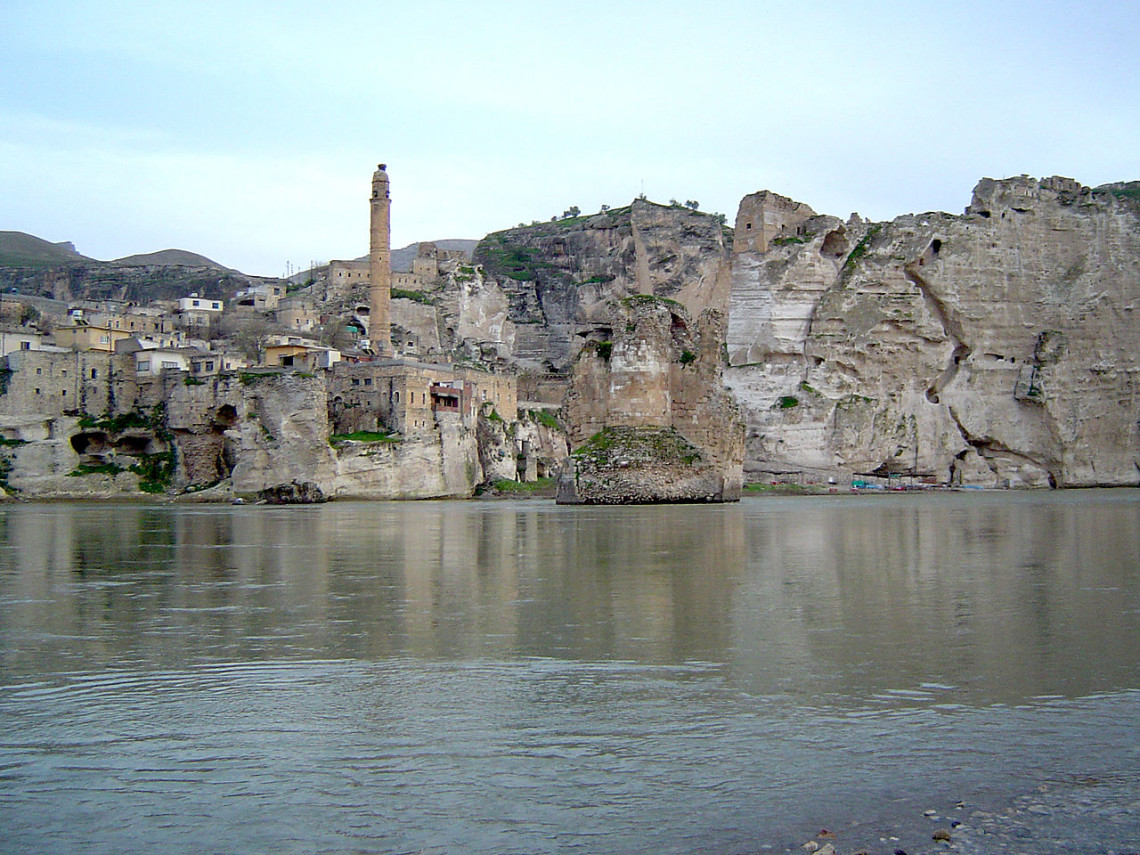 Hasankeyf
Hasankeyf The reason for stopping off the main road in those days would be to eat a fried fish lunch in one of Hasankeyf’s famous riverside restaurants. I remember sitting in a pleasant garden enjoying something like a tasty cod steak with a salad and then trying to find out from the waiter what exactly it was that he had recommended. He led me back into the kitchen where on a table lay the corpse of a giant cat fish. This was larger than a man and as ugly as sin, and obviously going to provide many more steaks that day.
Now there is a project for the Tigris: the great Ilisu dam construction which will by all accounts achieve wonders of hydro-electric power and irrigation to benefit the region and perhaps reduce separatist tensions. Large dam schemes, as we learn, almost always turn out to be very political projects with advantages and disadvantages all depending on your point of view. When modifying rivers of continental scale, there is inevitably an effect on international relations. Thus Egypt is unhappy about the water Sudan takes from the Nile, while Iraq and Syria accuse Turkey of stealing water from the Tigris and the Euphrates. In addition there are the ecological, social and cultural side effects. The original Swiss-led consortium building the Ilisu dam agreed a long list of mitigation measures with the Turkish government. These included arrangements for international co-operation on water resources, for environmental protection, for the resettlement of villages, and in particular for moving historical monuments uphill to a park to be provided by the Ministry of Culture with a contribution of 35 million USD.
By 2008 it had become apparent that almost none of the Ilisu conditions had been met by the Turkish authorities. Only 8 historical monuments had been moved. After some argument, the Swiss and other international investors pulled out of the project and there were world-wide cries for the whole of Hasankeyf to be protected by UNESCO as a heritage site. This has had no effect whatever. Of all things the present Turkish government most dislikes, being lectured by foreigners is at the top of the list. Veysel Eroglu, Minister of Forestry and the Environment, stated truculently: “We do not need their money. We will construct this dam at any cost.” Work continued with funding from Turkish banks and is now near completion. The dead-line has passed for the population to evacuate and Hasankeyf goes under the water next month.
I walked down to our little port over the holiday and despite all the flood water pouring down the Severn into the estuary, found from the dock that I had stumbled upon an exceptionally low tide. It almost looked as if you might walk across (and I know a man who did it). For a while I was wondering whether the sands had moved more than usual. Half a mile out, more of the steam-ship Ramses was showing than I can ever remember seeing. The story here is that in March 1951, when Britain was still under post-war rationing, this Egyptian registered ship which had loaded with Crimean wheat in Odessa, was being towed upstream to the grain silos across the estuary at Sharpness. The cable parted and the 6,000 ton vessel drifted into the Saniger Sands, which never let it go. The salvagers eventually cut everything away except the keel and lower hull, which you can still see on a low tide
I have a few reasons to feel cheerful about the coming year. At the very least it must surely turn out to be better for the nation than the last three, as most of the country people I talk to state with audible relief. I even have a hope that it might stop raining for a few days. At the year’s end, we seem to have a dry spell established at last. Given high pressure leading us into January and February, it’s sure to become colder. Let’s see what the rest of the winter brings for anglers: hopefully a time for searching the bottom either with heavy nymphs or the trotting rod. As for choosing fishing methods in the cold, I tend to be reminded of Dickens’ character Mr Micawber, whom I will now proceed to misquote: “Air temperature plus 1 degree, rod rings clear, result happiness! Air temperature minus 1 degree, rod rings blocked, result misery!” Micawber was actually speaking of income and expenditure of course, or the sad case of those who are “not financially viable” as they say in the USA. My point here is that you really can’t trot with any ease if the air temperature is at freezing or below. Trotting rods have tiny rings, usually lined, and quickly block up with ice making the business of trying to run the float down for any distance a real misery. I have heard that smearing glycerine on the rings may help, but to a limited extent. If it’s below zero, fishing heavy nymphs under the rod top is a much better option as rings on fly rods are that much larger, don’t block so quickly, and with this method you are not working a wet line back and forth through the rings so much. I once fished a match on the Dee with the temperature at minus 10 degrees and all of us caught fish, although leaders became ropes of icy globules (and I fell in, which pleased me not much, and my old Landrover failed to start at the end of the day, which pleased me even less). A still better idea for a hard frost is to use a Tenkara rod and the nymphs on a fixed length leader. You may end up with an icy rope below the rod top, but you will be able to fish.
Happy New Year and Tight lines!
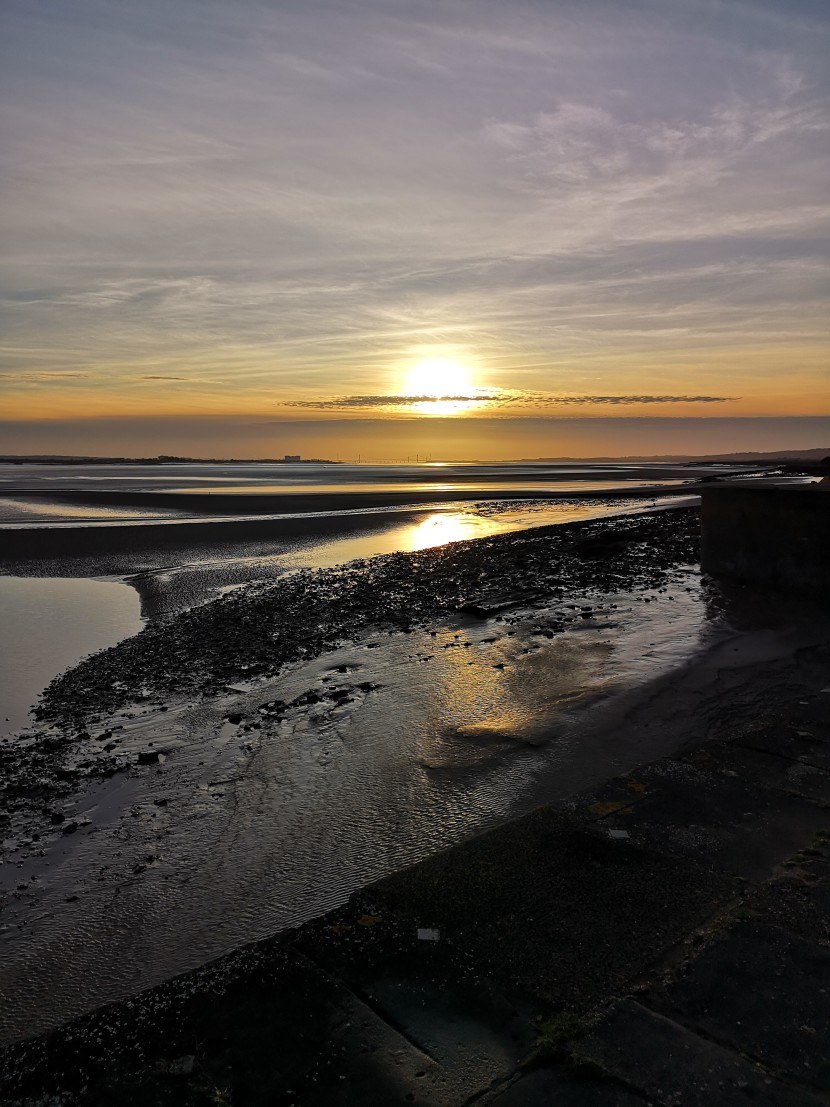 Year's end
Year's end Oliver Burch